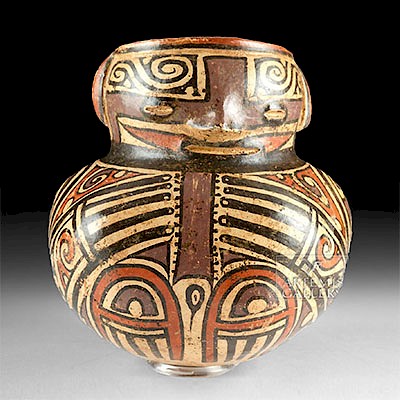Large Costa Rican Guanacaste Redware Olla
Lot 72c
About Seller
Artemis Fine Arts
686 S Taylor Ave, Ste 106
Louisville, CO 80027
United States
Selling antiquities, ancient and ethnographic art online since 1993, Artemis Gallery specializes in Classical Antiquities (Egyptian, Greek, Roman, Near Eastern), Asian, Pre-Columbian, African / Tribal / Oceanographic art. Our extensive inventory includes pottery, stone, metal, wood, glass and textil...Read more
Estimate:
$900 - $1,350
Absentee vs Live bid
Two ways to bid:
- Leave a max absentee bid and the platform will bid on your behalf up to your maximum bid during the live auction.
- Bid live during the auction and your bids will be submitted real-time to the auctioneer.
Bid Increments
| Price | Bid Increment |
|---|---|
| $0 | $25 |
| $300 | $50 |
| $1,000 | $100 |
| $2,000 | $250 |
| $5,000 | $500 |
| $10,000 | $1,000 |
| $20,000 | $2,500 |
| $50,000 | $5,000 |
| $100,000 | $10,000 |
| $200,000 | $20,000 |
About Auction
By Artemis Fine Arts
Nov 8, 2018
Set Reminder
2018-11-08 10:00:00
2018-11-08 10:00:00
America/New_York
Bidsquare
Bidsquare : Ancient / Ethnographic From Around The World
https://www.bidsquare.com/auctions/artemis-gallery/ancient-ethnographic-from-around-the-world-3598
Ancient art from Egypt, Greece, Italy and the Near East, as well as Asian, Pre-Columbian, Native American, African / Tribal / Oceanic, Spanish Colonial, Russian Icons, Fine art, much more! Artemis Fine Arts info@artemisgallery.com
Ancient art from Egypt, Greece, Italy and the Near East, as well as Asian, Pre-Columbian, Native American, African / Tribal / Oceanic, Spanish Colonial, Russian Icons, Fine art, much more! Artemis Fine Arts info@artemisgallery.com
- Lot Description
Pre-Columbian, Costa Rica, Guanacaste, ca. 400 to 850 CE. A sizable hand-built polychrome olla with a stable, round-bottomed form rising to a globular body, a gradually-tapering neck, and a flared rim. The neck is decorated with a repeating register of red and black pyramidal and circular motifs on an orange ground, all enclosed with two black stripes above and three below. The front of the vessel depicts an abstract anthropomorphic head with round, black-painted eyes, tapered cheeks, a mouth filled with small teeth, a brow adorned with zigzag and linear motifs, and a surrounding headdress comprised of small rings and two lengthy tassels. Highly-burnished and covered in red slip, this is a fabulous example from ancient Costa Rica! Size: 13" W x 11.625" H (33 cm x 29.5 cm).
Many ancient cultures of the Americas built grand pyramids - the Olmec, Maya, Aztec, and Inca for example all created pyramids to honor/house their deities and bury their kings. The Pyramid of the Sun and the Pyramid of the Moon in Teotihuacan, the Castillo at Chichen Itza in the Yucatan, the Aztec's Great Pyramid in Tenochtitlan, and the Pyramid of Cholula and the Inca's capital in Cuzco probably come to mind. However, Costa Rica is not known for such massive pyramids. So the fact that this piece depicts pyramidal motifs is quite interesting. Was the artisan aware of the pyramids created by fellow Pre-Columbian civilizations? Was this an aspiration for the cultures of Costa Rica? Or were pyramids simply part of the collective visual culture vocabulary of the Pre-Columbian world?
Provenance: private Los Angeles County, California, USA collection
All items legal to buy/sell under U.S. Statute covering cultural patrimony Code 2600, CHAPTER 14, and are guaranteed to be as described or your money back.
A Certificate of Authenticity will accompany all winning bids.
We ship worldwide and handle all shipping in-house for your convenience.
#136038Vessel repaired from several large pieces with some resurfacing, overpainting, and light adhesive residue along break lines. Surface wear and abrasions commensurate with age, small nicks and chips to rim, neck, face, and body, with fading to some areas of pigmentation. Light root marks on base, and nice earthen and mineral deposits throughout. Old inventory number written in black ink and old inventory sticker on base.Condition
- Shipping Info
-
All shipping is handled in-house for your convenience. Your invoice from Artemis Gallery will include shipping calculation instructions. If in doubt, please inquire BEFORE bidding for estimated shipping costs for individual items.
-
- Buyer's Premium



 EUR
EUR CAD
CAD AUD
AUD GBP
GBP MXN
MXN HKD
HKD CNY
CNY MYR
MYR SEK
SEK SGD
SGD CHF
CHF THB
THB
















